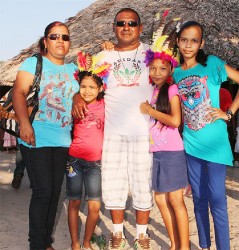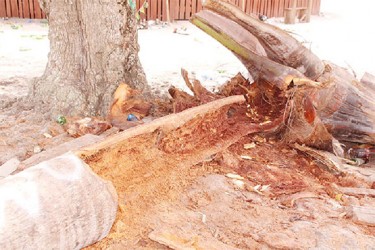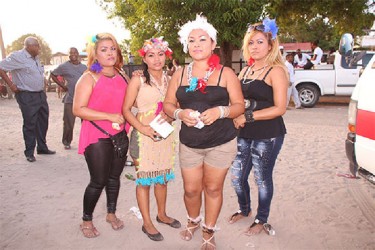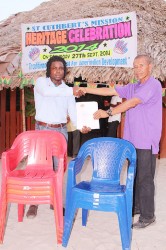For 20 years St Cuthbert’s Mission has been holding an annual Amerindian Heritage celebration typically on the last weekend of Amerindian Heritage Month, September.
While the Ministry of Amerindian Affairs selects one community every year to be the official Heritage village to celebrate and conclude the month-long events, St Cuthbert’s has maintained its heritage festival.
At the festivities held from September 26 to 29, Toshao Luke Simon said St Cuthbert’s has had a strong tradition of celebrating its heritage day since 1995.

“This year’s celebrations I strongly feel is one of the most successful celebrations. For one thing, we have our own benab now,” he said. The benab he speaks of was completed in December 2013 and sits in the centre of the village. It measures 60 feet in diameter and 50 feet in height and is now the largest benab in the country, following the destruction of Georgetown’s Umana Yana on September 9.
A stage was constructed in the benab and 200 chairs arranged for comfortable seating. The village council bought 70 chairs, while 100 chairs were officially donated to the St Cuthbert’s community by Aurora Gold Mines.
Among attendees were Prime Minister Samuel Hinds, Minister in the Ministry of Agriculture Ali Baksh and Permanent Secretary of the Ministry of Amerindian Affairs Nigel Dharamlall. Officials from the Region 4, Demerara-Mahaica Regional Democratic Council were also present.

One of the key Heritage Day celebrations was the official opening of the benab, but this was taken off the schedule due to the no-show of Minister of Amerindian Affairs Pauline Sukhai. She was also scheduled to officially open the newly built guest house which was constructed to boost St Cuthbert’s Mission’s eco-tourism drive. Despite the Prime Minister being present, the Toshao remarked that only the minister can officially open the benab, which was the main venue for the cultural celebrations held on September 27.
Sukhai’s absence was said to be due to her attendance at the United Nations Permanent Forum on Indigenous Issues.
Nevertheless, the cultural programme commenc-ed with the introduction of the importance of remembrance of culture by Leeland Clenkian.
There were dance performances from the Edris Dance group, cultural dances such as the hook dance, Mari-Mari dance, Hummingbird dance and circle dance.
The Mighty Pakuri, famed for his songs “Guy-ana my home”, “Arawak man”, “Shifoda”, “Ten Regions” and “Cassava Mama”, told Stabroek News after his performance that every year he sings for the people of the Mission as a tribute to their culture and history as a community. “I am originally from St Cuthbert’s and this is my hobby, a talent I do. It is more cultural oriented. It’s about bringing all people together, not Amerindians alone,” Pakuri said. He also sang his latest song, “Rich Culture”.
After a dance by the Amanda Dance Group came a skit, “Kanaima man” that expressed Amerindian folklore and storytelling. There was also a presentation depicting ethnicity by the primary school students of the Mission, followed by a story presentation of the

Pakuri folk.
The Edris cultural group demonstrated the processing of cassava before a Piwari drinking contest between men and women.
The village council presented awards to several residents: Anasha Williams for being the top National Grade Six performer of the community; Avinash Poonsammy, the top Caribbean Secondary Education Certificate performer; Brenda Causway, for Education and Community Service; Telford Taylor, Sports and Community Service; Amanda Mahadeo, Culture, Health and Agriculture; the Toshao for Teaching and Community Service and Ridley Ferreira for Sports.

Side attractions included tug-o-war, cassava processing, sack races, archery and the official bursting of the Ite palm for Tacoma worms. Residents collected them and subsequently fried them in a pan or roasted them on sticks to eat.
There was an exhibition of arts and craft at the craft centre and food, fruits and drinks were on sale: Piwari, Cassava bread and pepperpot were in abundance.
The next day, Sunday September 28, was the ‘Wash Down’ as the locals call it at the ‘Landing’ a creek-like area on the Mahaica River where the sandy bank was used for partying all day until sunset.




